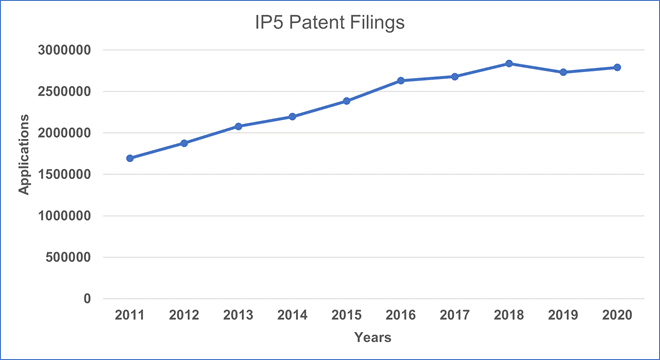Gain new perspectives for faster progress directly to your inbox.

The sustainability of the global patent system is under pressure from the rapid growth in patent application volume and complexity. In countries seeing the fastest growth in filings, capacity gaps delay patent prosecution, put patent quality at risk, reduce customer satisfaction, and slow the pace of innovation and investment.

Increasing application timeliness and patent quality
Reducing application delays is a common priority among patent offices as they seek to improve customer satisfaction and foster innovation. Delays in the process create legal uncertainty for inventors and cause them to be leery of making investments. One of Brazil’s foremost patent attorneys, Juliano Ryota Murakami, a partner with Gusmao & Labrunie, highlighted the risks to IP stakeholders:
“Excessive delays in patent examinations harm a country's innovation and economic development. They discourage companies from seeking legal protection for their inventions, since, when the patent is finally granted, the technology protected in it may be totally outdated and obsolete. They also generate uncertainty about the exclusivity of reproduction and the potential commercialization of inventions.”
The burden of ensuring application timeliness and patent quality falls largely on patent examiners and is dependent on their ability to quickly find relevant prior art to expedite reviews. However, prior art searches are time-consuming, requiring complex search strategies and deep subject matter expertise.
An EPO analysis of search activity by its staff shows that a comprehensive patent application search draws on 1.3 billion technical records in 179 databases, leading to about 600 million documents appearing in search results on a monthly basis. Not surprisingly, a study by the Japan Patent Office estimated that examiners spend about 40% of their time performing prior art searches and reviewing results. Patent quality can suffer if examiners lack the time, subject matter expertise, or technical resources to easily access prior art.
AI-enabled search solutions can play an important role across the entire patent ecosystem in improving both efficiency and patent quality. They can support faster examinations within patent offices and can allow innovators to identify prior art earlier, avoiding the time and cost of prosecution or validity challenges for bad patents. This is why the AI prior art algorithms were added to the CAS SciFinder Discovery Platform and STNext® solutions for improving scientific and IP searches.
New approaches support sustainability
Application delays and inefficiencies are being resolved through measures that ensure the long-term operational sustainability of patent offices. The European Patent Office (EPO) has sustainability objectives for an engaged staff, digital transformation, an effective patent granting process, and high-impact international cooperation. Other offices are setting similar priorities for enhancing organizational effectiveness.
To provide faster, higher quality examinations, offices are hiring more patent examiners, deploying time-saving technologies such as AI, and transforming their workflows:
- The USPTO hired hundreds of examiners in 2021 to handle growing workloads in keeping with its strategic plan for optimizing patent quality and timeliness. It also is expanding the implementation of AI for patent classifications and searches to give examiners easier access to prior art.
- In anticipation of double-digit application growth in 2021, the UK Intellectual Property Office doubled its examiner headcount in the previous year. Its 5-year program to streamline and modernize processes aims to achieve efficiencies of at least 3.5% of core operating costs. It also is evaluating how to make the best use of AI as it invests more in service delivery.
- The EPO, in a key initiative called “Master the Prior Art,” is improving classification procedures to increase search accuracy and retrieve relevant documents earlier in examinations. It is systematically applying artificial intelligence, machine learning and other technologies to create a more efficient end-to-end, digital patent granting process.
AI-enabled solutions can be used by patent offices for many functions beyond prior art searches. These include classifications assignment and conversion, APIs for more efficient document delivery, online tools for reviews and analysis, and more. By enhancing efficiency, patent quality, and customer service, these solutions can create a multiplier effect for helping offices achieve strategic objectives for operational sustainability and global innovation.
AI and workflow transformations show promise in reducing application delays
CAS recently completed a project with The National Institute of Industrial Property (INPI) of Brazil that streamlines prior art searches through a unique blend of curated data, artificial intelligence, custom workflow, and outsourced IP search services. The project generated significant benefits:
- Up to 50% reduction in examination times
- 77% of all national applications processed required less examiner search time
- 29% of all national applications processed required little or no additional search
- Productivity gains contributed to a reduction of 80% in the office’s backlog
Learnings for optimizing AI performance in prior art search
AI is receiving growing attention from patent offices for its ability in quickly analyze millions of data sets and deliver relevant results. According to WIPO, more than 70 AI-related projects are underway in 27 offices, including 19 that focus on prior art searches and examination procedures
Our work with INPI Brazil reinforced several foundational principles for optimizing the application of AI in prior art searching:
- Clean, structured data significantly improves predictive accuracy
- Multiple algorithms are needed to return similarities with the highest relevance
- Augmenting technology with human expertise improves outcomes
Data Quality: Most publicly available non-curated scientific and patent data present inherent challenges for patent offices. They often include transcription errors, mislabeled units, and overly complex patent language. Foreign languages present special challenges.
Human-curated data that has been normalized, prepared, and connected in a structured format improves the training of AI algorithms and increases the performance of prior art searches. Curated data reveal more patents with similarities and identify adjacent patents that could raise obviousness concerns.
Multiple Algorithms: The use of multiple algorithms customized for specific search methodologies improves AI performance. In Brazil, we developed 10 algorithms to deliver the first round of results. Another algorithm for ensemble learning analyzed those findings to produce a final set of highly relevant, ranked results.
Optimized Workflows: Our custom workflow solution for INPI Brazil cut the number of prior art search steps in half. It also saves time by making patent and non-patent search results, references, and tools for sorting, filtering, and visualization available through a single cloud-based interface. Custom workflows can be fully automated or include outside search experts who can validate algorithm models and filter searches to augment examiner capacity.
Interested in learning more about AI-enabled workflow approaches in patent offices and how predictive technology can help ensure the sustainability of the entire intellectual property ecosystem? Read our CAS Insights Report - "Addressing Sustainability of the Global Patent System: The Role of AI in Enhancing Productivity



